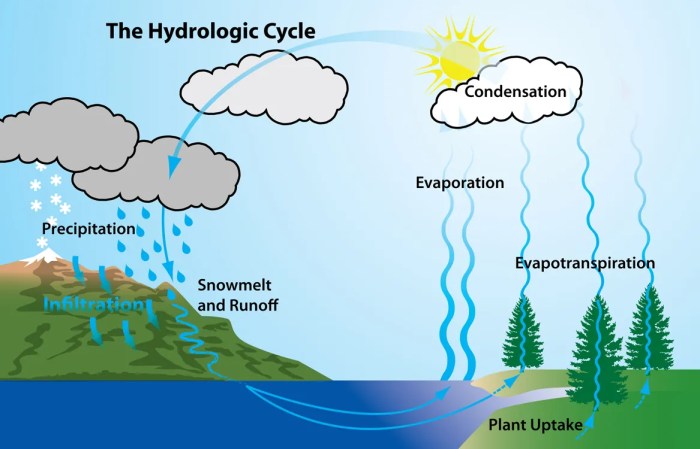The water cycle review of terms and concepts worksheet – The Water Cycle: A Comprehensive Review of Key Terms and Concepts introduces a critical examination of the intricate processes involved in the Earth’s water system. This worksheet delves into the fundamental terminology and concepts that underpin our understanding of this vital cycle, providing a comprehensive resource for students, educators, and anyone seeking to deepen their knowledge of water’s journey.
Through engaging explanations, illustrative diagrams, and thought-provoking questions, this worksheet unveils the mechanisms that drive the water cycle, from evaporation and condensation to precipitation and runoff. It explores the impact of human activities on this delicate system and emphasizes the importance of water conservation for the sustainability of our planet.
1. The Water Cycle
Key Terms

The water cycle, also known as the hydrologic cycle, is the continuous movement of water on, above, and below the surface of the Earth. It involves the exchange of water between the atmosphere, land, and oceans.
Precipitation
Precipitation refers to any form of water that falls from the sky, including rain, snow, sleet, and hail. It is the primary mechanism by which water returns to the Earth’s surface.
Evaporation
Evaporation is the process by which liquid water transforms into water vapor and enters the atmosphere. It occurs when water is heated by the sun or other sources.
Condensation
Condensation is the process by which water vapor in the atmosphere cools and condenses into liquid water droplets, forming clouds.
Transpiration
Transpiration is the process by which plants release water vapor into the atmosphere through their leaves. It is a crucial part of the water cycle, contributing significantly to the amount of water vapor in the air.
Runoff
Runoff refers to the flow of water over the land’s surface, including streams, rivers, and lakes. It occurs when precipitation exceeds the infiltration capacity of the soil.
Infiltration
Infiltration is the process by which water seeps into the ground, replenishing groundwater aquifers. It is an essential component of the water cycle, as it prevents excessive runoff and soil erosion.
2. Water Cycle
Concepts and Processes

The Process of the Water Cycle
The water cycle is a continuous process that involves the following stages:
- Evaporation from oceans, lakes, rivers, and other water bodies
- Condensation of water vapor into clouds
- Precipitation in the form of rain, snow, sleet, or hail
- Runoff and infiltration of water into the ground
- Transpiration from plants
Human Impact on the Water Cycle
Human activities can significantly impact the water cycle, including:
- Deforestation, which reduces transpiration and increases runoff
- Urbanization, which increases impervious surfaces and reduces infiltration
- Water withdrawals, which deplete water bodies and alter the flow of water
Importance of Water Conservation
Water conservation is crucial for maintaining the balance of the water cycle and ensuring a sustainable water supply. Benefits of water conservation include:
- Reduced water shortages
- Lowered energy consumption for water treatment and transportation
- Improved water quality
Methods for Promoting Water Conservation
Individuals can promote water conservation through:
- Fixing leaks in faucets and pipes
- Watering lawns and gardens efficiently
- Installing low-flow appliances
Role of Technology in Water Cycle Management, The water cycle review of terms and concepts worksheet
Technology plays a vital role in monitoring and managing the water cycle, including:
- Remote sensing to track water resources
- Hydrological models to predict water availability
- Smart water meters to monitor water consumption
Key Questions Answered: The Water Cycle Review Of Terms And Concepts Worksheet
What is the significance of the water cycle?
The water cycle is crucial for maintaining the Earth’s balance and supporting life. It ensures a continuous supply of fresh water, regulates temperature, and influences weather patterns.
How do human activities affect the water cycle?
Human activities such as deforestation, urbanization, and pollution can disrupt the water cycle by altering precipitation patterns, increasing runoff, and contaminating water sources.
What are some ways to promote water conservation?
Water conservation measures include reducing water consumption, implementing water-efficient technologies, and adopting sustainable agricultural practices.